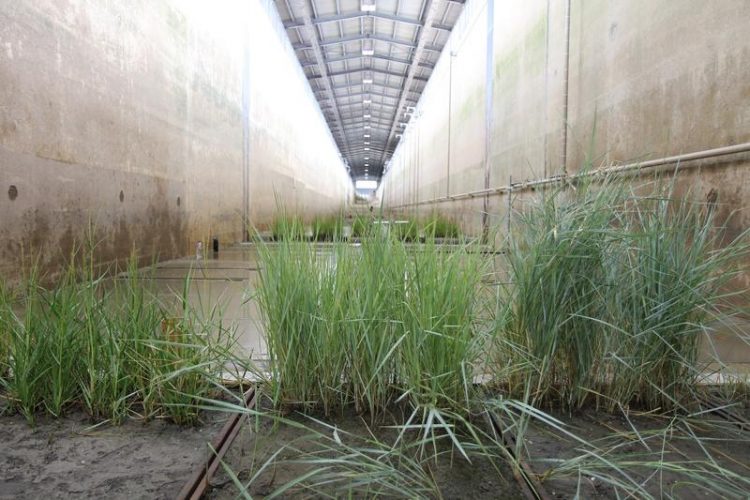Climate Impact Research in Hannover: Small Plants against Large Waves

Silt grass in the wave channel UHH/MIN/Latos
Salt marsh plants such as cordgrass and sea club-rush protect coastal areas in storm surge conditions and provide a buffer for approaching waves. But what happens to the vegetation if storm surges occur more frequently or become more severe in the course of climate change? And how will this impact coastal erosion?
An international research team is currently exploring these questions in a unique experiment in the Large Wave Flume at the Coastal Research Centre, a joint facility of Leibniz University Hannover and TU Braunschweig. The research results could illustrate the consequences of climate change for the invaluable role of tidal marsh in providing protection against coastal erosion.
Salt marshes occur on shallow coasts influenced by tides. They provide a habitat for adapted plants and animals, protect the coast, and contribute to climate protection as they store carbon dioxide from the atmosphere. However, if storm surges occur more frequently due to climate change, the system might become imbalanced and lose its protective function for the coast.
To date, researchers can neither predict the resistance of tidal marshes against more frequent or more severe flooding nor what kind of storm surges might destroy them. Salt marshes are considerably more complex than dunes or sand beaches. On the one hand, they contain large quantities of silt and loam, resulting in “sticky” soil. On the other hand, their protective vegetation is more or less pronounced.
Within the framework of the Hydralab+ project RESIST (“Response of Ecologically-mediated Shallow Intertidal Shores and their Transitions to extreme hydrodynamic forcing”), an international team will address these issues by analysing the effects of heavy swells on seedlings and fully-grown plants of different species, as well as the effect of soil composition on coastal erosion. Over a period of three weeks, researchers at the Large Wave Flume in Hannover will expose various salt marsh plants as well as sediment samples to large waves and storm surges.
In March 2018, researchers collected plants such as cordgrass and sea club-rush in the Netherlands. Subsequently, they planted them in wooden boxes, which were then positioned in five different soil zones of the Large Wave Flume.
For instance, in one zone the team will study the effects of storm surges in summer and winter. For this, some plants were drained in order to simulate dieback due to drought. Researchers will use another zone to test new erosion control equipment made from potato starch. The mesh is fixed to the ground inside the boxes and should protect both seedlings and sediment against waves.
A total of 18 sediment drill cores will also be used in the experiment, which the RESIST team extracted from the silty east coast and the sandy west coast of the UK in July. Researchers examined the texture and condition by means of a micro CT scanner in Cambridge. The drill cores will be opened at the side and fixed at the end of the Large Wave Flume. This is where they will be exposed to the waves, enabling researchers to track the progress of erosion after each wave cycle.
The project is led by the University of Cambridge (UK), in collaboration with Universität Hamburg (Germany), TU Braunschweig (Germany), University of Antwerp (Belgium), as well as the Royal Netherlands Institute for Sea Research.
The Large Wave Flume at the Coastal Research Centre
The Large Wave Flume at the Coastal Research Centre is a joint research facility of Leibniz University Hannover and TU Braunschweig. Measuring 5 metres in length, 7 metres in depth and comprising a usable length of 307 metres, it is one of the largest wave flumes worldwide. The hydraulic wave generator simulates continuous waves and swells under deep and shallow water conditions. In addition, it generates continuous waves up to two metres high, as well as wave spectrums with significant wave heights of up to 1.3 metres.
Contact persons (contact details for interviews available upon request)
– Dr. Iris Möller, University of Cambridge, Coastal Research Unit
-Dipl.-Ing. Matthias Kudella, Leibniz Universität Hannover, Coastal Research Centre
– Dr. Stefanie Nolte, Universität Hamburg, Applied Plant Ecology
– Dr. Maike Paul, Technische Universität Braunschweig, Institute of Geoecology
Contact:
Maria Latos
Universität Hamburg
Faculty of Mathematics, Informatics and Natural Sciences
Communications and Collaborations
Tel.: +49 40 42838-8109
Email: maria.latos@uni-hamburg.de
Photos are available upon request.
Media Contact
More Information:
http://www.uni-hannover.deAll latest news from the category: Life Sciences and Chemistry
Articles and reports from the Life Sciences and chemistry area deal with applied and basic research into modern biology, chemistry and human medicine.
Valuable information can be found on a range of life sciences fields including bacteriology, biochemistry, bionics, bioinformatics, biophysics, biotechnology, genetics, geobotany, human biology, marine biology, microbiology, molecular biology, cellular biology, zoology, bioinorganic chemistry, microchemistry and environmental chemistry.
Newest articles

New 3D-printed microscale photonic lantern
Optical waves propagating through air or multi-mode fiber can be patterned or decomposed using orthogonal spatial modes, with far-ranging applications in imaging, communication, and directed energy. Yet the systems that…

Pyrolysis for high-quality recycled plastics
Plastics made of polycarbonate are sought-after materials in industrial applications thanks to their versatility and high quality. However, recycling of plastic waste is still running up against limits these days,…

Brain stimulation with 3D ultrasound to treat neurological diseases and conditions
Fraunhofer researchers have developed a technology that uses ultrasound signals for targeted stimulation of certain areas of the brain. A special ultra-sound system with 256 individually controllable transducers makes it…





















